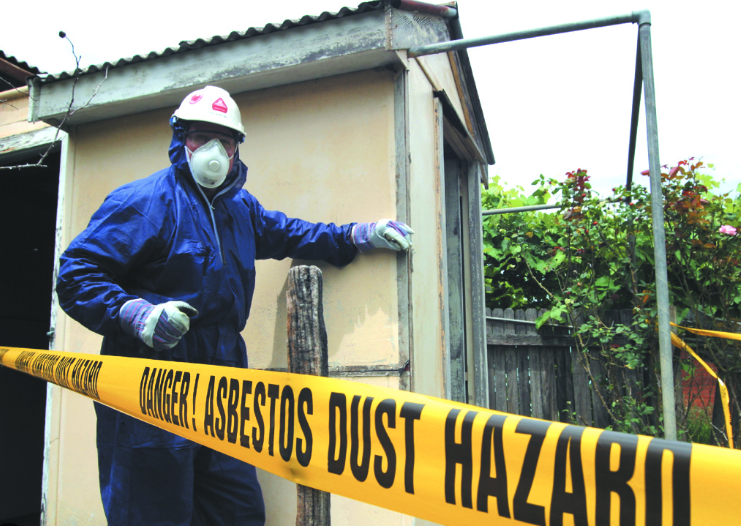Many PCBUs (persons conducting a business or undertaking) are unaware of their workplace health and safety duties regarding asbestos-risk management. Often the consensus is that an asbestos inspection is all that must be carried out to fulfil regulatory requirements, unaware that obtaining an asbestos report is only the first step towards a safe and compliant workplace. One of the most crucial aspects of asbestos-risk management actions is remediation. In this article, we will examine these two equally important health and safety duties and the potential penalties for failing to fulfill them.
What is an Asbestos Inspection?
An asbestos inspection is a process of identifying the presence of asbestos-containing materials (ACMs) in a building. Asbestos inspections are usually conducted by professional companies that specialise in asbestos registers and management plans.
These companies should have qualified Licensed Asbestos Assessors (LAA) who conduct visual assessments of the building and collect samples of any suspected ACMs. The samples are then sent to a laboratory for testing to determine if and what type of asbestos fibres are present in the material.
Asbestos inspections are essential for determining whether any ACMs are present and their condition. A detailed asbestos audit report is then provided by the inspection company, which outlines the location and condition of any ACMs found, as well as recommendations for managing the risk of ACMs.
What are my Asbestos inspection duties?
In Australia, asbestos inspections are required for all commercial buildings built before 2004. This includes residential buildings acting as workplaces (where commercial work is carried out).
Under the Work Health and Safety Regulation 2017 (WHS 2017), a PCBU must manage the risk of asbestos exposure. It is a mandatory requirement that a copy of the Asbestos Register and Asbestos Management Plan be kept onsite and always made available to workers.
In Victoria, the Occupational Health and Safety (OHS) Regulation 2017 also requires a PCBU to manage the risk of exposure to asbestos by engaging an LAA to identify the presence of ACMs, conducting an asbestos audit, and preparing an Asbestos Register and an Asbestos Management Plan. In addition, a division 6 asbestos audit is required before any planned works, such as refurbishment, renovation, or demolition, take place.
It is a legal requirement that all asbestos-related documentation must be retained for a minimum of 30 years after the last entry is made. However, due to the latency of asbestos-related diseases, the longest being 20 – 50 years for mesothelioma, there is the argument to retain the proof of providing a safe and compliant work environment should the courts question this.
Why is Asbestos Remediation Important?
Asbestos remediation is essential for several reasons. Firstly, it helps protect the health and safety of those who live or work in buildings containing asbestos. Exposure to airborne asbestos fibres can cause serious health problems, including death. Remediation can help prevent this exposure.
Secondly, asbestos remediation can help to ensure compliance with regulations and guidelines related to asbestos management. In Australia, the WHS 2017 and OHS 2017 regulations govern the management, handling, and removal of ACMs. Failure to comply with these regulations can result in severe fines and legal action, which we will explore later in this article.
Finally, asbestos remediation can provide peace of mind for building owners and occupants. Knowing that asbestos has been safely remediated and managed can improve the safety and value of the property.

What are my Asbestos Remediation duties?
The PCBUs must provide a safe work environment by managing the risk of exposure to asbestos. In asbestos remediation terms, this means preventing the release of asbestos fibres into the atmosphere. Your asbestos report should identify the condition of the asbestos and provide management recommendations, including the application of one of the below methods where required.
Several methods of asbestos remediation include encapsulation, enclosure, and removal.
Encapsulation involves the application of a sealant to the surface of ACMs to prevent the release of asbestos fibres into the air. This method is often used for ACMs in good condition and not likely to be disturbed.
Enclosure involves the construction of an airtight barrier around the ACMs to prevent the release of asbestos fibres into the air. This method is often used for ACMs that are in good condition but may be disturbed during day-to-day practices.
Removal is the complete physical removal of ACMs from the building. This method is often used for ACMs in poor condition or with a high risk of being disturbed.
The method of remediation will depend on several factors, including the type and condition of the ACMs, the location of the ACMs, and the purpose of the remediation.
Failure to Comply with Health and Safety Duty
Each state or territory in Australia has slightly varying penalties regarding asbestos health and safety duties. For the sake of this article, we have generalised the WHS model, which is used by all states and territories apart from Victoria, which is seen to be the most progressive state in this field. In general, you can expect to find harsher penalties in VIC. Check with your local government for the latest updated penalties in your region.
A PCBU has a duty, so far as is reasonably practicable, to ensure the health and safety of workers and others who may be affected by the carrying out of work.
This duty of care is enforced by the three categories penalty system, in addition to a manslaughter charge. It is important to note that the Category 1 offence provides an alternative charge to industrial manslaughter if it cannot be established that the death of an individual results from neglect on the officer’s part.
Industrial Manslaughter
Industrial manslaughter offences are designed to ensure that workplace-related deaths caused by the conduct of persons conducting a business or undertaking (PCBU) and their officers are met with substantial penalties.
A person conducting a business or undertaking (PCBU) or an officer of a PCBU commits industrial manslaughter if they engage in conduct which breaches a health and safety duty and causes a person’s death. The PCBU or officer must have been reckless or negligent about causing the death. Depending on the state or territory, the maximum penalty is 20 to 25 years imprisonment for an individual and fines of $10 million to $16.5 million for a company.
WHS Penalty System
| WHS Penalty Category | Type of Alleged Failure | Maximum Potential Penalty |
| Category 1 | Failure to comply with a health and safety duty that causes the death of, or serious harm to an individual. | For an individual:5 years imprisonment and a fine of up to $680, 000 For a body corporate: A fine of up to $3,500,000 |
| Category 2 | Failure to comply with a health and safety duty that exposes an individual to a risk of death or of injury or harm to the individual’s health. | For an individual:A fine of up to $350,000 For a body corporate: A fine of up to $1,800,000 |
| Category 3 | Failure to comply with a health and safety duty. | For an individual:A fine of up to $120,000 For a body corporate: A fine of up to $570,000 |
Specific offences for asbestos reports
In addition to the category system, there are specific offences relating to asbestos registers and management plans. Please note that not all offences have been listed in the table below.
| Regulation number | Offence | Maximum potential penalty |
| R425(1) | Asbestos Register not kept on premises | $18,000 |
| R427 | Insufficient on-site access to the Asbestos Register | $18,000 |
| R428 | Failure to transfer the Asbestos Register during the transfer of management | $18,000 |
| R429 | Failure to ensure that the asbestos management plan is maintained. | $30,000 |
| R449 | Duty to provide the Asbestos Register to a person conducting asbestos work | $30,000 |
If you have any questions about the information in this article, please feel free to contact one of our experienced team. As our name suggests, we have clients right across the globe. Based in Australia, we also have specialised knowledge of Australian regulations around asbestos inspections and compliance.
